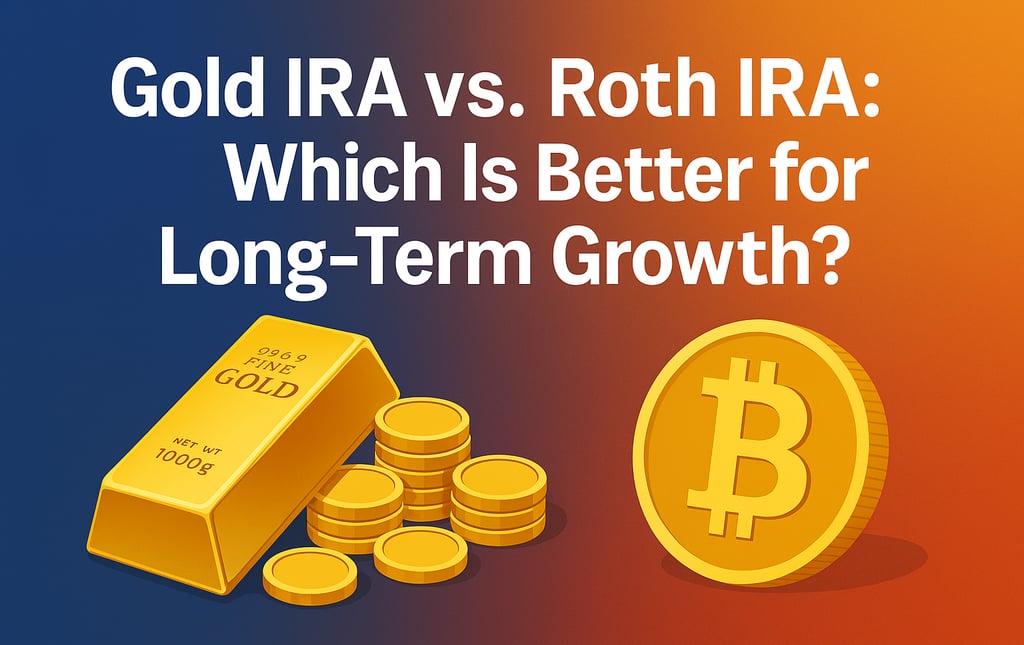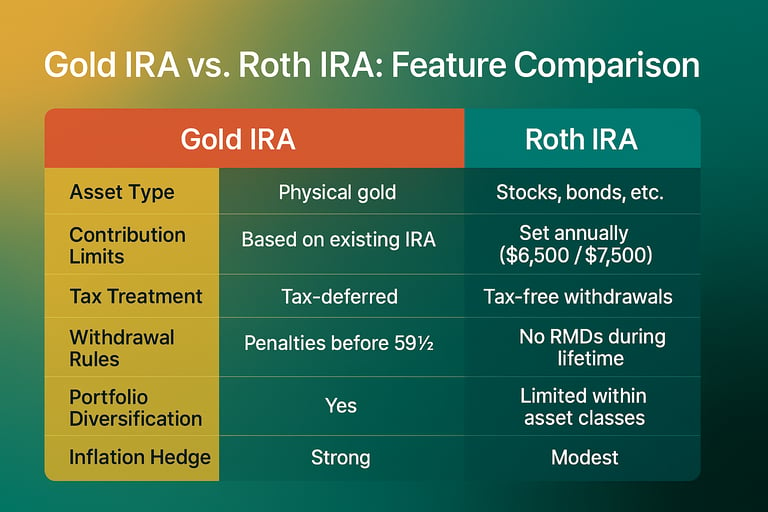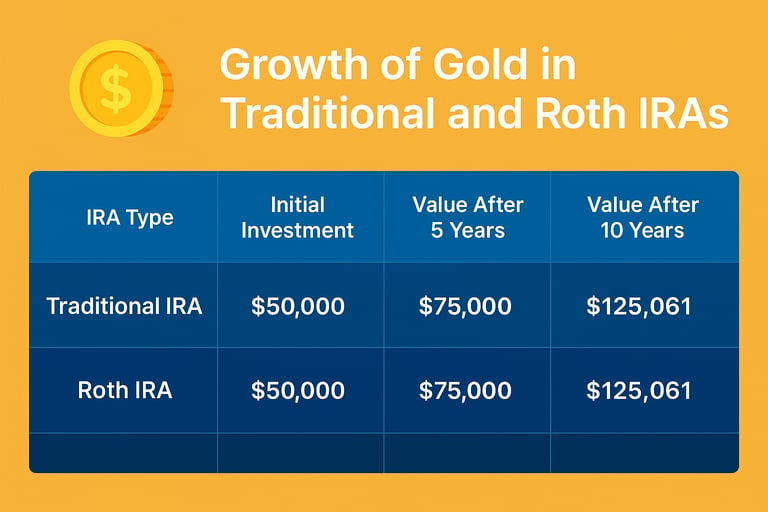Gold IRA vs. Roth IRA: Which Is Better for Long-Term Growth?
Discover the key differences between a Gold IRA and Roth IRA to determine which is better for your long-term growth strategy. This guide breaks down the pros, cons, tax advantages, and risk profiles of each to help you protect and grow your retirement portfolio. Learn when it makes sense to use both accounts together — and why diversification is the smartest move in today’s uncertain economy
GOLD IRA
Wellington Ashford
4/11/20254 min read


Gold IRA vs. Roth IRA: Which Is Better for Long-Term Growth?
When it comes to retirement planning, few decisions are as important as choosing the right type of IRA. While the traditional Roth IRA is well-known for its tax advantages and growth potential, the Gold IRA has gained traction in recent years as a hedge against inflation, currency risk, and stock market volatility.
But which account type delivers better long-term growth — and which one aligns best with your goals?
In this article, we'll compare a Gold IRA vs. Roth IRA across key areas like growth potential, risk, tax treatment, and long-term wealth preservation. Whether you’re building your retirement portfolio or considering a 401k rollover, this guide will help you make an informed decision.
What Is a Gold IRA?
A Gold IRA is a type of self-directed individual retirement account (SDIRA) that allows you to hold physical precious metals — like gold, silver, platinum, and palladium — inside a tax-advantaged retirement account.
You can fund a Gold IRA by:
Rolling over a 401k, traditional IRA, or other qualified account
Making annual contributions (subject to IRS limits)
Gold must be stored in an IRS-approved depository — not at home. You purchase IRS-approved coins or bullion bars, and your custodian handles the storage and compliance.
Primary purpose: Preservation of purchasing power and diversification away from volatile paper assets.
What Is a Roth IRA?
A Roth IRA is a retirement account funded with after-tax dollars, meaning you pay taxes on the money upfront, but all future growth and withdrawals in retirement are tax-free (if you meet age and holding requirements).
Roth IRAs typically hold:
Stocks
ETFs
Mutual funds
Bonds
Some self-directed Roth IRAs can also hold alternative assets like real estate or gold, though these are less common.
Primary purpose: Compound growth and long-term tax-free retirement income.






Which One Offers Better Long-Term Growth?
It depends on your definition of “growth.” Let’s break it down:
📈 Capital Appreciation (Roth IRA Advantage)
Stocks and mutual funds typically offer higher short-term and long-term returns, averaging 6–8% annually over time.
A Roth IRA that holds market-based assets benefits from compounding returns — ideal if you're starting young.
🛡️ Wealth Preservation (Gold IRA Advantage)
Gold tends to hold value when stocks crash or inflation spikes.
During crises (2008, 2020), gold surged while equities dropped — helping investors avoid major drawdowns.
Ideal for older investors or those focused on capital preservation vs. accumulation.
“Gold is not about growth, it’s about security. It’s the anchor when everything else breaks loose.”
— Jim Rickards, Economist
Which IRA Performs Best During Inflation?
Inflation is the Achilles heel of traditional retirement accounts.
Roth IRA: While long-term stock investments can outpace inflation, short-term inflationary spikes can devastate portfolios.
Gold IRA: Gold has historically been a strong hedge against inflation, maintaining or increasing value as currency loses purchasing power.
2022–2023 Example:
S&P 500 fell ~20%
Gold prices remained stable and even increased slightly
Verdict: In inflationary environments, Gold IRAs provide critical balance.
Can You Combine Both?
Absolutely. Many investors open both a Roth IRA and a Gold IRA as part of a diversified strategy.
This offers:
Growth from equities
Stability from gold
Tax-free withdrawals from the Roth
Safe-haven protection from the Gold IRA
Example Portfolio Allocation:
70% Roth IRA (stocks, mutual funds)
30% Gold IRA (physical gold & silver)
“Don’t put all your eggs in one basket. But make sure one of those baskets is made of gold.”
— Robert Kiyosaki
Tax Differences: Roth IRA vs. Gold IRA
Roth IRA:
Funded with after-tax dollars
Tax-free withdrawals after age 59½
No required minimum distributions (RMDs)
Gold IRA:
Most are Traditional IRAs (pre-tax dollars)
Tax-deferred until you withdraw
Subject to RMDs starting at age 73 (as of 2023 SECURE Act 2.0)
You can take distributions in gold or cash
Note: You can open a Roth Gold IRA, but it's less common and more complex to set up.
Who Should Choose a Gold IRA?
Choose a Gold IRA if you:
Are concerned about inflation or the dollar’s decline
Are nearing or in retirement and want to protect what you’ve built
Want tangible assets instead of digital or paper assets
Believe the market is overpriced or unstable
Who Should Choose a Roth IRA?
Choose a Roth IRA if you:
Are in a lower tax bracket now than you expect at retirement
Have 20+ years to grow your investments
Want high liquidity and flexibility in your account
Don’t mind market swings for higher long-term returns


Final Verdict: Which Is Better?
There’s no one-size-fits-all answer.


Learn More
Ready to explore each option deeper? Start with:
Invest
Secure
Trustworthy
© 2024 GoldIRARolloverGuide.net. All rights reserved.
